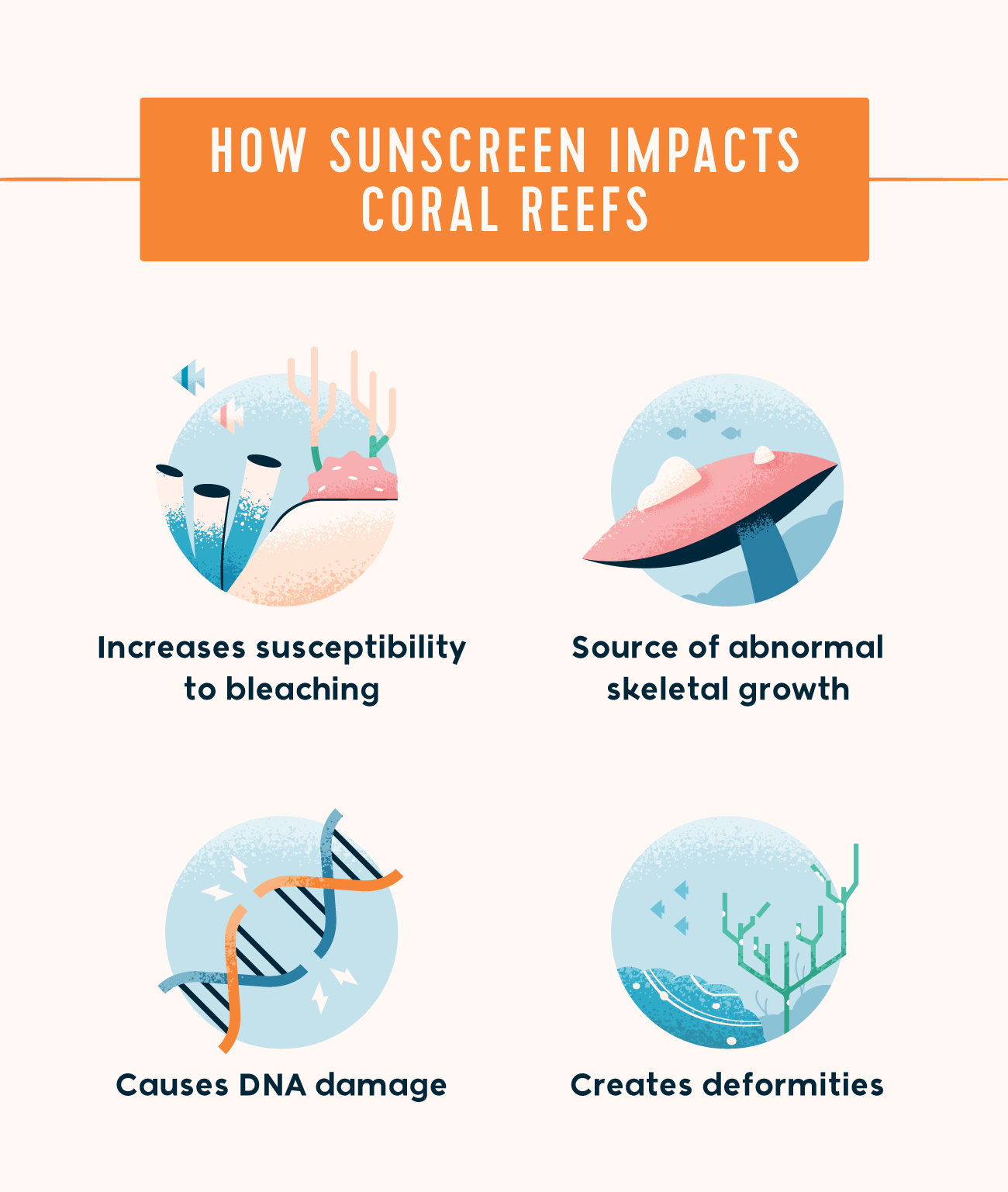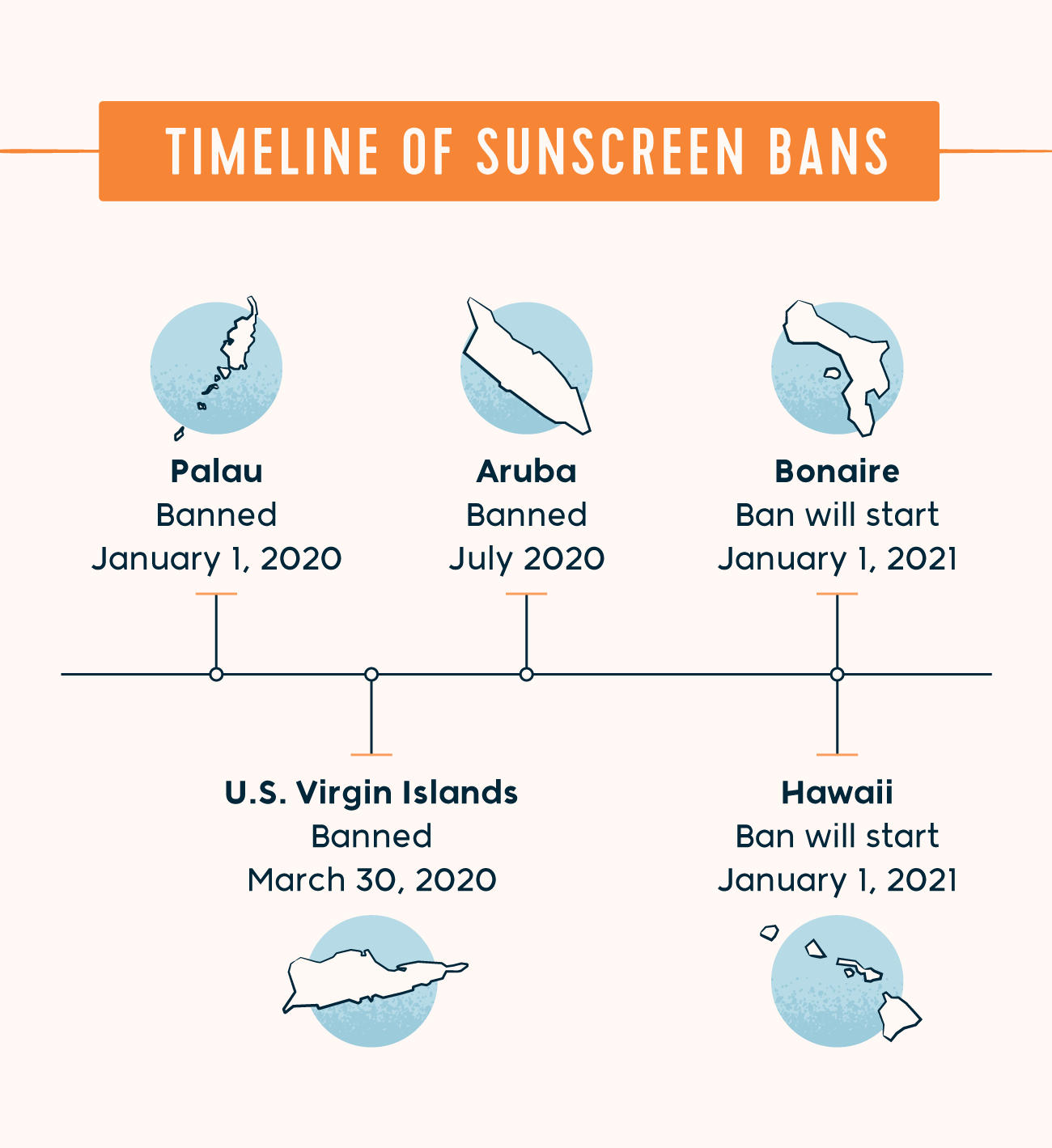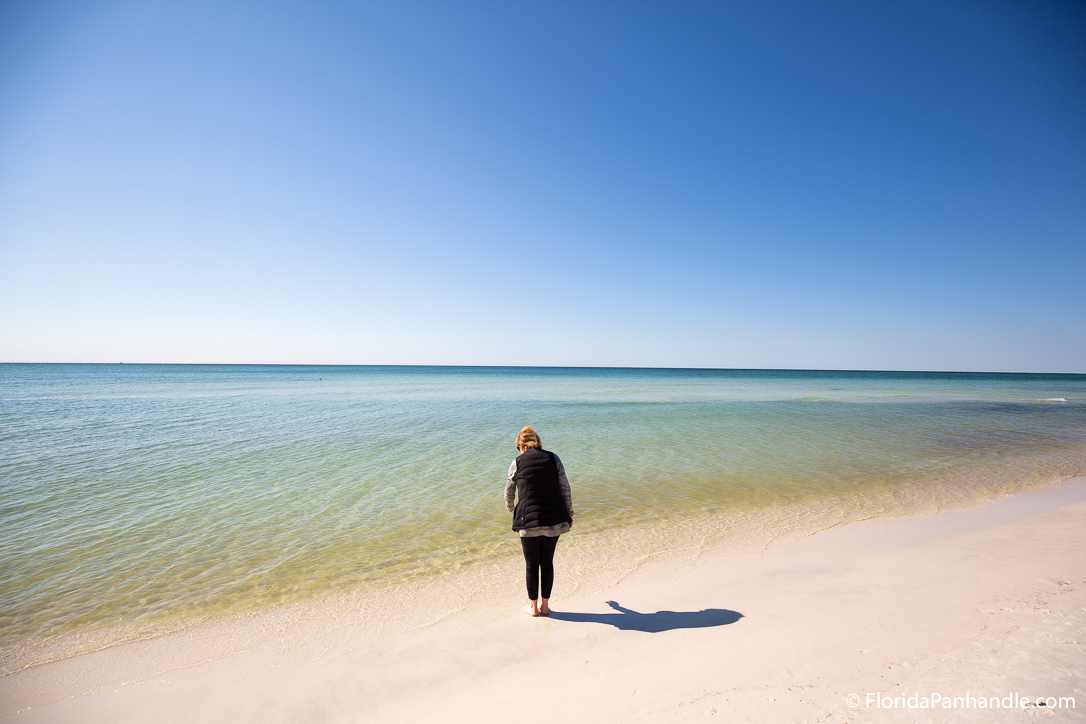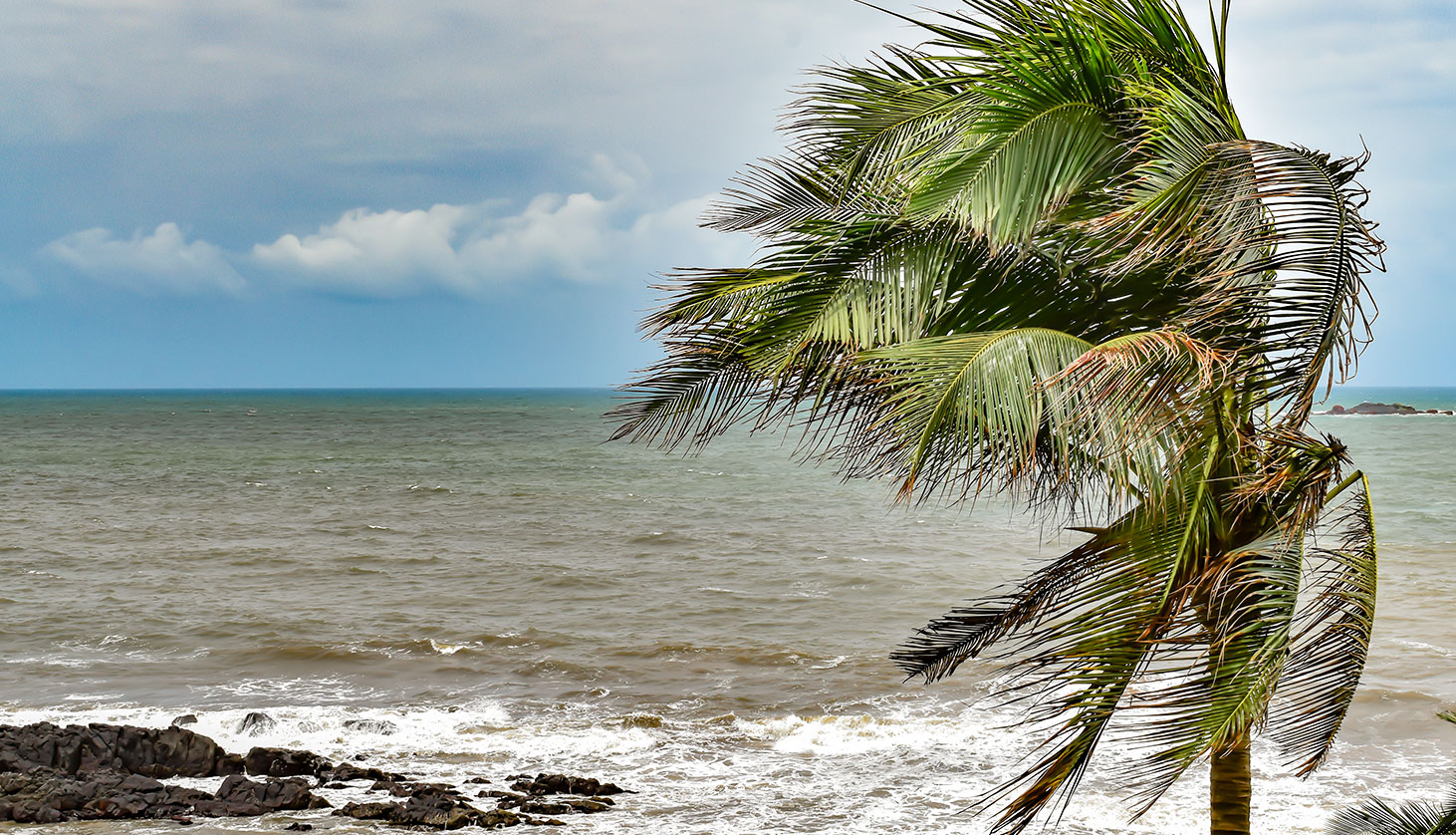It’s no secret that sunscreen is important to staying safe under the sun!
Unfortunately, the sunscreen that protects us often means “danger” for our friends in the sea.
The National Park Service says 4,000 to 6,000 tons of sunscreen is found annually in reef areas. High-traffic areas that host activities like snorkeling and diving are home to higher concentrations of sunscreen than less visited areas. You might be wondering, “Why does this matter?”
Many popular sunscreen ingredients like oxybenzone are known to bleach and kill coral reefs. In addition to harming reefs, the National Oceanic and Atmospheric Administration (NOAA) found that sunscreen chemicals cause reproduction, growth and immune system complications for sea wildlife.
Bans on sunscreen with harmful ingredients are already in place in a few areas. However, these ingredients are still present in many popular brands. Unfortunately, grabbing “reef safe” labeled sunscreen doesn’t solve the problem either, as the use of the term “reef safe” isn’t regulated. Instead, you’ll need to know the difference between safe and harmful ingredients yourself.
Below, we dive into well-known toxic sunscreen ingredients and give tips for picking reef-friendly sunscreen.
Sunscreen Ingredients to Avoid
Researchers have identified several ingredients that are harmful to both sea life and human life. The most well-known are oxybenzone and octinoxate. These ingredients are commonly found in popular sunscreen brands. However, they’re not the only ingredients you should avoid!
Some ingredients may be considered safe because of limited testing or because of the way it’s used. For example, some ingredients may be deemed safe in low concentrations, but may become harmful if larger concentrations wash into the ocean. This is the issue occurring in high-traffic areas like snorkeling and diving spots.

Studies on Toxic Sunscreen Ingredients
Oxybenzone is a sunscreen ingredient that many studies have found responsible for coral bleaching and other harmful outcomes for the ocean. A study published in the Archives of Environmental Contamination and Toxicology explained the damaging effects of oxybenzone pollution in coral reefs, specifically citing the ability of the chemical to deform plant life.
Another study in the Journal of the American Academy of Dermatology cites oxybenzone, along with octinoxate, octocrylene and 4-methylbenzylidene camphor, as a danger to the ocean’s food chain –– these ingredients were found in various species of fish. A study published in the Federation of American Societies for Experimental Biology also found that exposure to oxybenzone, titanium dioxide and zinc oxide-based sunscreen resulted in coral bleaching.
The Science of the Total Environment contains several studies on these toxic ingredients. One study found that oxybenzone, along with avobenzone, octocrylene and octinoxate, inhibit the growth of sea cucumber plants. Another study touches on the dangerous accumulation of octocrylene in zebrafish.
A study published in Environmental Science and Technology found methyl parabens in sea creatures like fish, invertebrates and seagrasses. Parabens were also found in sea water and ocean sediments. Another study published in Environmental Health Perspectives found that paraben, cinnamate, benzophenone and camphor derivatives caused coral bleaching, even at low concentrations.
A study published in Marine Pollution Bulletin found that 4-methylbenzylidene camphor, benzophenone-3, octinoxate, homosalate and octocrylene were found in high concentrations near the U.S. Virgin Islands.

Below are a handful of ingredients to watch out for the next time you go shopping for reef-safe sunscreen.
- Oxybenzone
- Octinoxate
- Octocrylene
- Parabens (Methyl Paraben, Butyl Paraben)
- 4-methylbenzylidene camphor (4MBC)
Stream2Sea and the Haereticus Environmental Laboratory keep a list of ingredients that are not only harmful to coral reefs, but also to both sea and human life. Some toxic sunscreen ingredients are also found in personal care products like lotion and shampoo. If you want to be extra safe, scan the ingredients on all of your products at home to see if you’re using harmful chemicals!
Tips for Picking Reef Safe Sunscreen
Picking a reef safe sunscreen takes extra care –– you’ll need to look through the ingredients list and other features of the product. Here are a few things you should keep in mind when choosing a new sunscreen:
- Check the label for any toxic ingredients. Some sunscreens may be labeled “oxybenzone-free.” This is a good sign, but you should still check the full ingredients list before purchasing new sunscreen. You can also check the sunscreen’s website for detailed information on ingredients.
- Look for non-nanotized zinc oxide or titanium oxide. “Non-nanotized” means that ingredients are at least 100 nanometers in diameter. A literature review from Nova Southeastern University found that sunscreens that only have non-nanotized zinc oxide or non-nanotized titanium dioxide as their main UV filter lessen the stress on sea life and coral. Non-nanotized is also better for us since ingredients aren’t absorbed by the skin and pose less dangers than nanoparticles.
- Don’t immediately purchase a bottle with a “reef safe” label. The term “reef safe” doesn’t have an agreed upon definition and isn’t regulated by the government. This makes reef-safe sunscreen shopping extra tough, as any company can add a “reef safe” label to their bottles without proven testing.
- Get a water-resistant sunscreen. Less sunscreen washing off into the ocean is good news for everyone! You’re more likely to have it on while you’re in the water and the ocean has less sunscreen in it.
- Understand what “ocean safe” might mean. “Ocean safe” may just mean that the product is highly water-resistant and doesn’t wash off. Although this is a great feature, the “ocean safe” label might not take the ocean’s health into account..
- Choose mineral or physical sunscreens instead of chemical sunscreens. The National Park Service recommends physical sunscreens over chemical sunscreens. Chemical sunscreens use synthetic ingredients to absorb the sun’s rays and are more likely to use some of the toxic ingredients listed above. Physical sunscreen normally uses safer minerals to block sun rays.
- Avoid spray sunscreens. Aerosol, or spray, sunscreens easily spreads the product in the air and surrounding area. Once it drops into the sand, it can get washed away into the sea.

Safely using less sunscreen is another way you can be kind to the ocean. Less sunscreen on your body means there’s less chance of sunscreen washing into the sea. To do this, you can cover up at the beach and invest in UPF (ultraviolet protection factor) clothing to protect your skin. Umbrellas and sun tents are other non-sunscreen ways to keep you and your loved ones out of the sun.
List of Reef Safe Sunscreen
There are plenty of sunscreens on the market that claim to be “reef safe,” but they may not be truly safe for ocean life. We’ve rounded up a few brands that are true reef-safe options.
Before putting anything new on your skin, you should consult with your doctor or dermatologist, especially if you have an allergy to a specific ingredient..
- Badger Balm Clear Zinc Unscented Sunscreen Lotion
- MANDA Organic Sun Paste (SPF 50)
- Babo Botanicals Clear Zinc Sunscreen Lotion SPF 30 – Summer Scent
- Thinksport Safe Sunscreen SPF 50+
- Sunscreen for Body SPF 30
- Kōkua Sun Care Hawaiian Natural Zinc Sunscreen SPF 50
- Suntegrity UNSCENTED Natural Mineral Sunscreen for Body 3 oz. Broad Spectrum SPF 30
Areas With Sunscreen Bans
Around the world, some areas are banning the use of certain sunscreen ingredients due to the harmful effects they have on reefs and ocean life. Below are all of the areas with a ban currently in place, as well as areas with plans to implement a ban in the future..
Palau
The beautiful archipelago of Palau banned “reef-toxic sunscreen” on January 1, 2020. Anyone selling or distributing reef-toxic sunscreen will have their sunscreen confiscated and receive a fine no higher than $1,000. Palau defines reef-toxic sunscreen as any product containing oxybenzone, octyl methoxycinnamate, octocrylene, 4-methylbenzylidene or other specific ingredients.
U.S. Virgin Islands
The sunscreen ban in the U.S. Virgin Islands took effect on March 30, 2020. Their law bans the sale, distribution and importation of sunscreen containing the “toxic 3 Os”: octocrylene, octinoxate and oxybenzone. Toxic sunscreen owners will need to dispose of their sunscreen and will be fined $1,000 on their first offense.
Aruba
Aruba began prohibiting the sale, import and production of products with oxybenzone in July 2020.
Hawaii
Starting January 1, 2021, Hawaii will ban the sale, offer of sale or distribution of sunscreen that has oxybenzone or octinoxate without a prescription from a licensed healthcare provider.
Bonaire
Bonaire will prohibit the use of sunscreen products containing oxybenzone or octinoxate by January 1, 2021.

What about Florida?
Key West Florida had a ban in place for 2021 on certain toxic sunscreen ingredients, but proposal SB 172 allows the state of Florida power over local governments in issues regarding regulation of over-the-counter drugs and cosmetics. Chapter 2020-118 explains this in detail.
Sunscreen is crucial for keeping us safe against the sun, but reef safe sunscreen is key to keeping both human life and sea life safe from harm. The next time you take a vacation to fun diving spots like Pensacola Beach, make sure you pack sunscreen that’s safe for you and our friends in the ocean.





